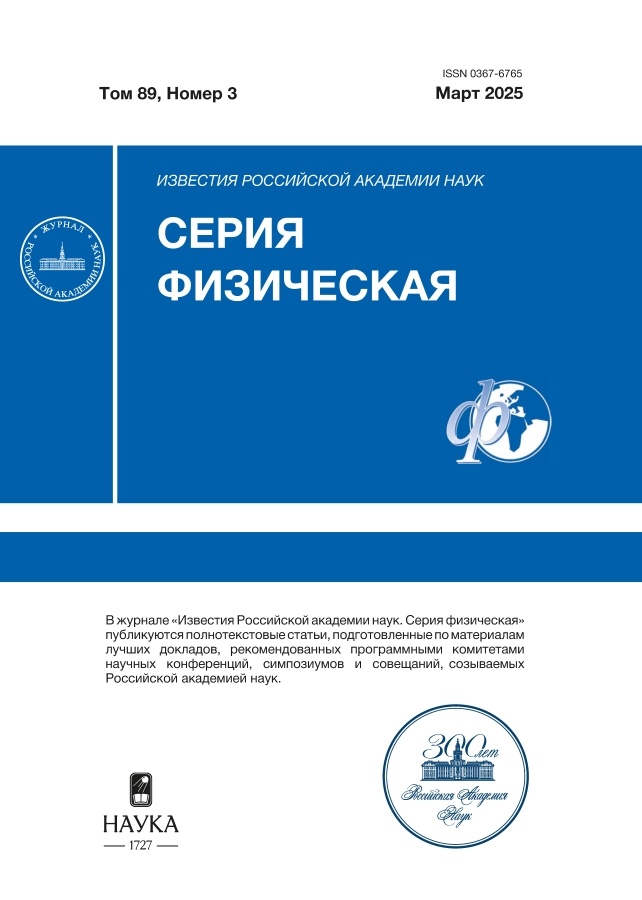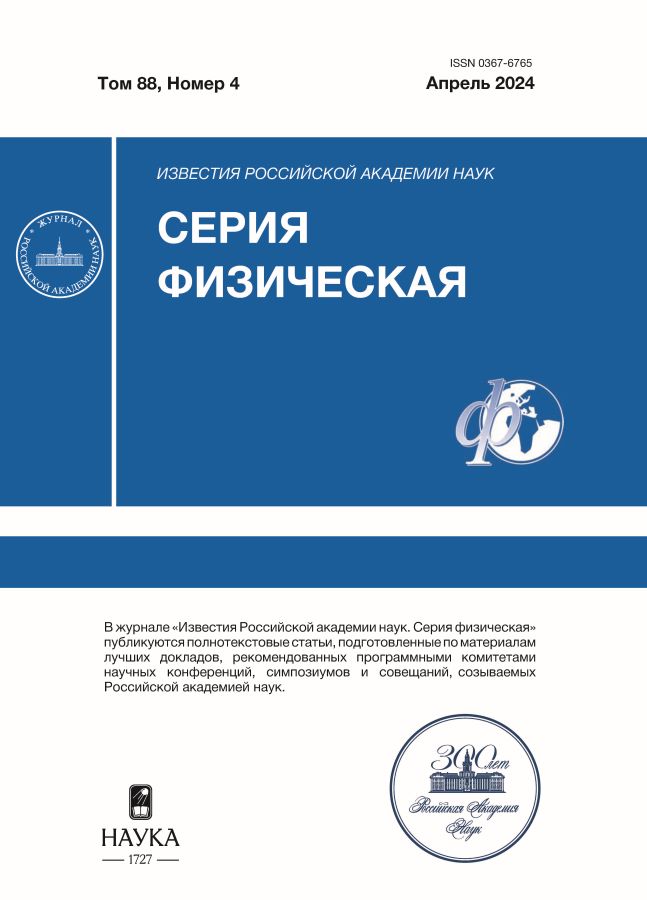Elastic properties of a magnetic elastomer
- Authors: Stepanov G.V.1, Storozhenko P.A.1
-
Affiliations:
- State Research Institute for Chemistry and Technology of Organoelement Compounds
- Issue: Vol 88, No 4 (2024)
- Pages: 660-667
- Section: Magnetic Phenomena and Smart Composite Materials
- URL: https://ta-journal.ru/0367-6765/article/view/654714
- DOI: https://doi.org/10.31857/S0367676524040197
- EDN: https://elibrary.ru/QGSBUH
- ID: 654714
Cite item
Abstract
Magnetoactive (aka magnetorheological) elastomer is a composite material consisting of an elastic matrix and magnetic filling substance. A study dedicated to the relationship between its viscoelastic parameters and the strength of the external magnetic field has been done. Under the influence of a field, the material can demonstrate elasticity and viscosity increased by ten folds. The elastic properties of the composite remaining under those conditions heavily depend on the degree of deformation of the sample. Thus, this type of magnetic composite is a prospective material for being used as the working body in controllable dampers.
Full Text
About the authors
G. V. Stepanov
State Research Institute for Chemistry and Technology of Organoelement Compounds
Author for correspondence.
Email: gstepanov@mail.ru
Russian Federation, Moscow, 105118
P. A. Storozhenko
State Research Institute for Chemistry and Technology of Organoelement Compounds
Email: gstepanov@mail.ru
Russian Federation, Moscow, 105118
References
- Liao G.J., Gong X.L., Xuan S.H. // J. Intell. Mater. Syst. Struct. 2012. V. 23. No. 1. P. 25.
- Liao G.J., Gong1 X.L., Kang C.J. et al. // Smart Mater. Struct. 2011. V. 20. Art. No. 075015.
- Hu G., Guo M., Li W. et al. // Smart Mater. Struct. 2011. V. 20. No.12. P. 1.
- Sun S.S., Chen Y., Yang J. // Smart Mater. Struct. 2014. V.23. No. 7. Art. No. 075009.
- Li W.H., Zhang X.Z., Du H. Advances in elastomers I: blends and interpenetrating networks. Berlin: Springer, 2013. P. 357.
- Ahamed R., Choi Seung-Bok, Ferdaus M.M. // J. Intell. Mater. Syst. Struct. 2018. V. 29. No. 10. P. 2051.
- Sun S., Deng H., Yang J. et al. // J. Intell. Mater. Syst. Struct. 2015. V. 26. No. 14. P. 1757.
- Kavlicoglu B., Wallis B., Sahin H., Liu Y. // Act. Pass. Smart Struct. Integr. Syst. 2011. V. 79. P. 770.
- Kim H.K., Kim H.S., Kim Y.-K. // Smart Mater. Struct. 2016. V. 26. No. 1. Art. No. 015016.
- Samir B., Kumbhara S.P., Chavana S.S., Gawad E.B. // Mech. Syst. Signal Process. 2018. V. 100. P. 208.
- https://ro.uow.edu.au/eispapers1/619.
- Du G., Huang X., Li Y. et al. // Smart Mater. Struct. 2017. V. 26. Art. No. 095024.
- Kim Y.-K., Koo J.-H., Kim K.-S., Kim S. // IEEE/ASME International Conference on Advanced Intelligent Mechatronics (Beijing, 2011). P. 1.
- Fu J., Zheng X., Yu M. et al. // IEEE/ASME International Conference on Advanced Intelligent Mechatronics (Wollongong, 2013). P. 1.
- Xu Z., Yang J., Gu Y. et al. // J. Guid. Control Dyn. 2016. V. 39. No. 3. P. 677.
- Yu G.-J., Wen X.-X., Du C.-B., Guo F. // Adv. Mater. Sci. Eng. 2019. P. 1.
- Boczkowska A., Awietjan S.F. // Mater. Sci. Forum. 2010. V. 636–637. Art. No. 766.
- Rigbi Z., Jilken L. // J. Magn. Magn. Mater. 1983. V. 37. P. 267.
- Shiga T., Okada A., Kurauchi T. // J. Appl. Polym. Sci. 1995. V. 58. P. 787.
- Stewart W.M., Ginder J.M., Elie L.D. Method and apparatus for reducing brake shudder. US. Patent 5816587, 1998.
- Jolly M.R., Carlson J.D., Munoz B.C. // J. Intell. Mater. Syst. Struct. 1996. No. 7. P. 613.
- Jolly M.R., Carlson J.D., Munoz B.C. // Smart Mater. Struct. 1996. V. 5. P. 607.
- Demchuk S.A., Kuz’min V.A. // J. Eng. Phys. Thermophys. 2002. V. 75. No. 2. P. 396.
- Bellan C., Bossis G. // Int. J. Mod. Phys. B. 2002. V. 16. No. 17–18. P. 2447.
- Zhou G.Y. // Smart Mater. Struct. 2003. V. 12. P. 139.
- Jolly M.R., Carlson J.D., Munoz B.C., Bullions T.A. // J. Intell. Mater. Syst. Struct. 1996. V. 7. P. 613.
- Zhou G.Y. // Smart Mater. Struct. 2004. V. 13. P. 1203.
- Coquelle E., Bossis G. // Adv. Science. 2005. V. 17. No. 1–2. P. 132.
- Gong X.L., Zhang X.Z., Zhang P.Q. // Polym. Test. 2005. V. 24. P. 669.
- Lerner A.A., Cunefare K.A. // J. Intell. Mater. Syst. Struct. 2008. V. 19. No. 5. P. 551.
- Böse H. // Int. J. Mod. Phys. B. 2007. V. 21. No. 28–29. P. 4790.
- Schrittesser B., Major Z., Filipcsei G. // J. Phys. Conf. Ser. 2009. V. 149. Art. No. 012096.
- Kchit N., Lancon P., Bossis G. // J. Physics D. 2009. V. 42. Art. No. 105505.
- Picken An H., Mendes S.J. // Soft Matter. 2010. V. 6. P. 4497.
- Hoang N., Zhang N., Du H. // Smart Mater. Struct. 2010. V. 20. Art. No. 015012.
- Yu M., Zhu M., Fu J., Yang P.A., Qi S. // Smart Mater. Struct. 2015. V. 24. No. 11. Art. No. 115021.
- Schubert G., Harrison P. // Polym. Test. 2015. V. 42. P. 122.
- Khairi M.H.A., Fatah A.Y.A., Mazlan S.A. // Int. J. Mol. Sci. 2019. V. 20. No. 17. Art. No. 4085.
- Sebald G., Nakano M., Lallart M. et al. // Sci. Technol. Adv. Mater. 2017. V. 18. No. 1. P. 766.
- Winger J., Schümann M., Kupka A., Odenbach S. // J. Magn. Magn. Mater. 2019. V. 481. P. 176.
- Stepanov G.V., Borin D. Yu., Raikher Yu.L. et al. // J. Phys. Cond. Matt. 2008. V. 20. Art. No. 204121.
- Chertovich A.V., Stepanov G.V., Kramarenko E. Yu., Khokhlov A.R. // Macromol. Mater. Eng. 2010. V. 295. P. 336.
- Stepanov G.V., Borin D.Yu., Odenbach S. // J. Phys. Conf. Ser. 2009. V. 149. No. 1. Art. No. 012098.
- Stoll A., Mayer M., Monkman G.J., Shamonin M. // J. Appl. Polym. Sci. 2014. V. 131. No. 2. Art. No. 39793.
- Böse H., Röder R. // J. Phys. Conf. Ser. 2009. V. 149. Art. No. 012090.
- Molchanov V.S., Stepanov G.V., Vasiliev V.G. et al. // Macromol. Mater. Eng. 2014. V. 299. No. 9. P. 1116.
- Abramchuk S.S., Grishin D.A., Kramarenko E. Yu., Stepanov G.V. // Polym. Sci. Ser. A. 2006. V. 48. P. 138.
- Stepanov G.V., Abramchuk S.S., Grishin D.A. et al. // Polymer. 2007. V. 48. P. 488.
- Sorokin V.V., Stepanov G.V., Shamonin M. et al. // Polymer. 2015. V. 76. P. 191.
- Sorokin V.V., Stepanov G.V., Shamonin M. et al. // Smart Mater. Struct. 2017. V. 26. Art. No. 035019.
- Sorokin V.V., Ecker E., Stepanov G.V. et al. // Soft Matter. 2014. V. 10. P. 8765.
- Stepanov G.V., Borin D.Yu., Kramarenko E.Yu. et al. // Polymer Sci. Ser. A. 2014. V. 56. No. 5. P. 603.
Supplementary files

















